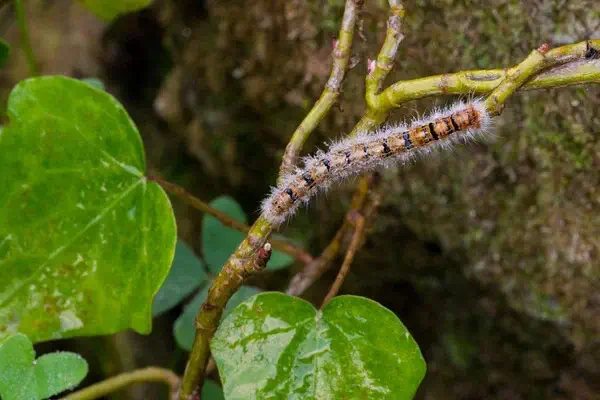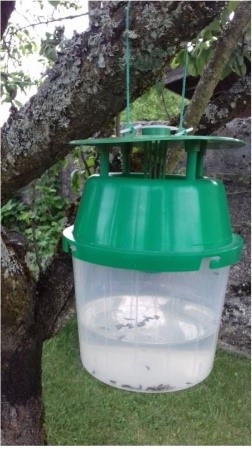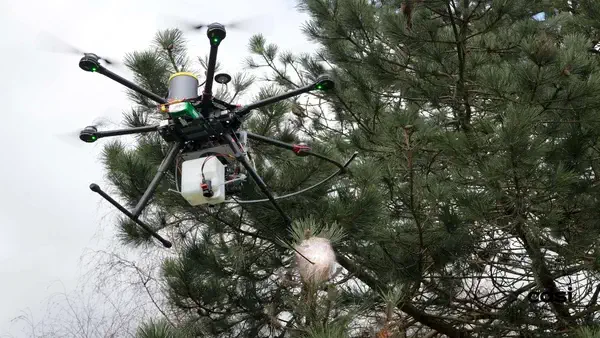We’ll discuss information about the processionary caterpillar here, a growing scourge in France and Europe due to rising temperatures caused by climate change. These caterpillars release highly irritating hairs into the air, which if they come into contact with your skin, can cause unsightly red rashes. These rashes require prompt medical attention, typically followed by a three-week course of antibiotics or in the case of children, it often leads to emergency room visits, and for pets, it means an urgent trip to the veterinarian.
Various solutions have been proposed to manage this problem, but according to INRAE, none have proven truly effective until now. We’ve innovated (again) by creating a drone system to treat processionary caterpillar nests with immediate, highly effective results in a 100% eco-friendly way. But first, here’s everything you need to know about this harmful insect.

Person injured by processionary caterpillars
Types of Processionary Caterpillars
Types of Processionary Caterpillars Processionary caterpillars are the larvae of moths belonging to the genus Thaumetopoea. Their name refers to their distinctive behavior: they move in a single-file line, resembling a procession. Two species are found in France: the oak processionary (Thaumetopoea processionea) and the pine processionary (Thaumetopoea pityocampa). These caterpillars are easily recognizable by their brown, hairy bodies and the silky nests they build in trees. Their lifecycle spans an entire year from egg hatch to metamorphosis into moths.

Oak Processionary Caterpillars
The oak processionary caterpillar is a species that feeds exclusively on oak trees. You can identify it by its dark gray body with lighter stripes and fine white hairs. In late spring, they create large, silken nests on trunks and major branches. Females lay eggs in summer, and larvae hatch the following spring. The larvae hatch the following spring and go through several developmental stages (5 to 6 molts). During the day, they remain clustered in the nest, emerging at night to feed on leaves. Once mature, they leave the tree and burrow into the soil to pupate, eventually transforming into moths by late summer.
The Pine Processionary Caterpillar
The pine processionary caterpillar (Thaumetopoea pityocampa) is a species commonly found in southern regions, covering nearly three-quarters of France, and particularly fond of pines and cedars. It’s easily recognized by its orange-brown body and rings of light -colored hairs. The life cycle begins at the end of summer, when the adult moth lays its eggs on pine needles. The eggs hatch in the autumn, and the young caterpillars immediately start feeding. They construct silky white nests high up in trees, which serve as shelter during winter. They continue to grow slowly through the cold months. In early spring, the caterpillars leave the nest in a distinctive single-file procession to burrow into the ground and pupate.
The Problems Caused by Processionary Caterpillars
Processionary caterpillars pose serious health and environmental risks. In the long term, these issues lead to significant economic losses , not only due to the cost of damage and treatment, but also through a decrease in tourism in affected regions.
Health Problems Caused by Processionary Caterpillars
The health risk to humans and animals primarily comes from the caterpillar’s urticating hairs, which are microscopic and released into the air. These hairs contain a toxin called thaumetopoein, which is released into the air and causes severe allergic reactions. For humans, symptoms range from itching and skin irritation to conjunctivitis and respiratory issues, which can be particularly dangerous for children. For animals, especially dogs, the effects can be life-threatening, causing necrosis in the mouth and, in some cases, death. As a result, areas infested with caterpillars pose a serious public health concern, often leading local authorities to close parks, schools, or play areas, and prompting individuals to avoid affected zones.
Environmental Problems Due to Processionary Caterpillar Expansion
Processionary caterpillars cause serious ecological damage due to their feeding behavior. By consuming pine needles and oak leaves, they cause large-scale defoliation that weakens trees and makes them more vulnerable to disease, wood-boring insects, and drought. Over time, this can stunt forest growth or even destroy private gardens. In regions like Corsica, entire forests have been devastated by these caterpillars, leading to severe consequences for both biodiversity and local ecosystems.
The Evolution of Processionary Caterpillars with Climate Change
In recent years, the population of processionary caterpillars has been growing rapidly across Europe. This expansion is largely driven by climate change, which accelerates their egg-laying and development cycles. Milder winters allow more eggs and larvae to survive, whereas in the past, prolonged frost helped limit their spread.
Originally confined to southern France, processionary caterpillars are now found in regions further north such as Hauts-de-France, Île-de-France, and even in Belgium. Their spread is also facilitated by rapid reproduction and the widespread planting of pine forests, their preferred habitat. According to France’s National Research Institute for Agriculture, Food and Environment (INRAE), these caterpillars are advancing 5 to 10 kilometers northward each year.
This ongoing expansion raises serious concerns. Since April 2022, pine processionary caterpillars have been officially classified as a “species harmful to human health” (Decree No. 2022-686 of April 25, 2022). Today, 85 departments in France are affected, with thousands of municipalities facing infestations, making effective monitoring and control essential.
Effective Solutions to Combat Processionary Caterpillars
Traditional Solutions
Over the years, several traditional methods have been used to combat processionary caterpillars, with varying degrees of success—though none offer a truly complete solution. The first is manual nest removal, which involves cutting and burning nests found in trees using poles or by climbing. While relatively effective for lower, accessible nests, this method is dangerous, time-consuming, and limited by height and reach.
The second technique involves using pheromone traps to attract male moths, or collar traps placed around tree trunks to capture caterpillars as they descend. These methods are only partially effective and work best in areas with low to moderate infestations. Additionally, they do not offer immediate results.
Lastly, there are biological treatments such as BTK (Bacillus thuringiensis kurstaki), which can be effective under strict weather conditions. However, their use is restricted in populated areas due to health risks, and the results are often inconsistent.

Our Effective Drone Solution for Treating Processionary Caterpillar Nests
For several years now, we have offered a highly effective drone-based solution that goes beyond simply spraying a treatment product. Our drones precisely target and destroy the entire nest, eliminating all caterpillars inside instantly and with maximum efficiency.
Unlike traditional approaches, our method works in all locations, including hard-to-reach tree canopies, and delivers rapid, nearly immediate results without any risk to the environment. It is a fully ecological solution.
Each operation is tracked in real time through a connected web application, allowing you to monitor the treatment of each nest, view geolocated data, and ensure thorough coverage across your property or region.


























